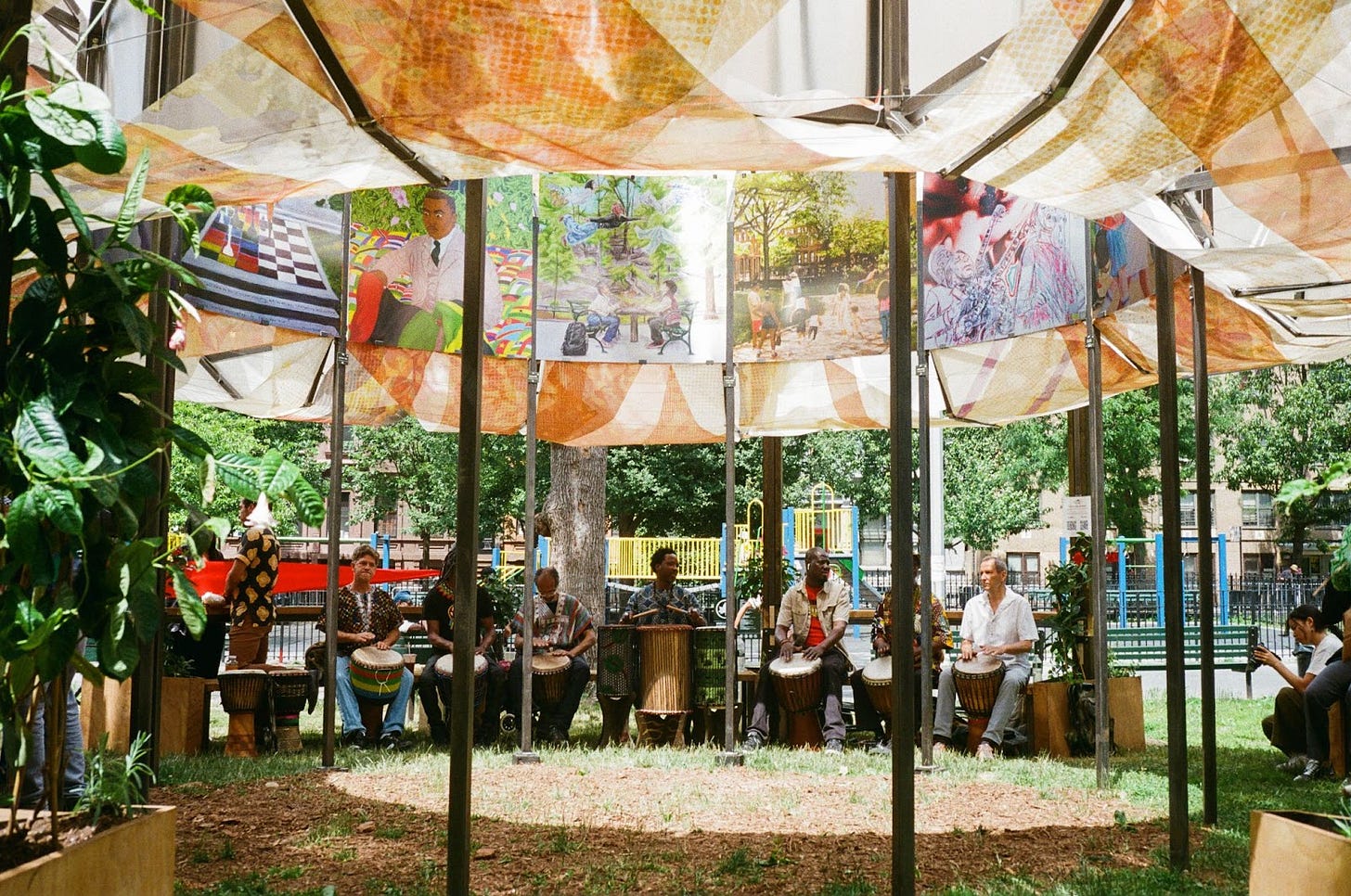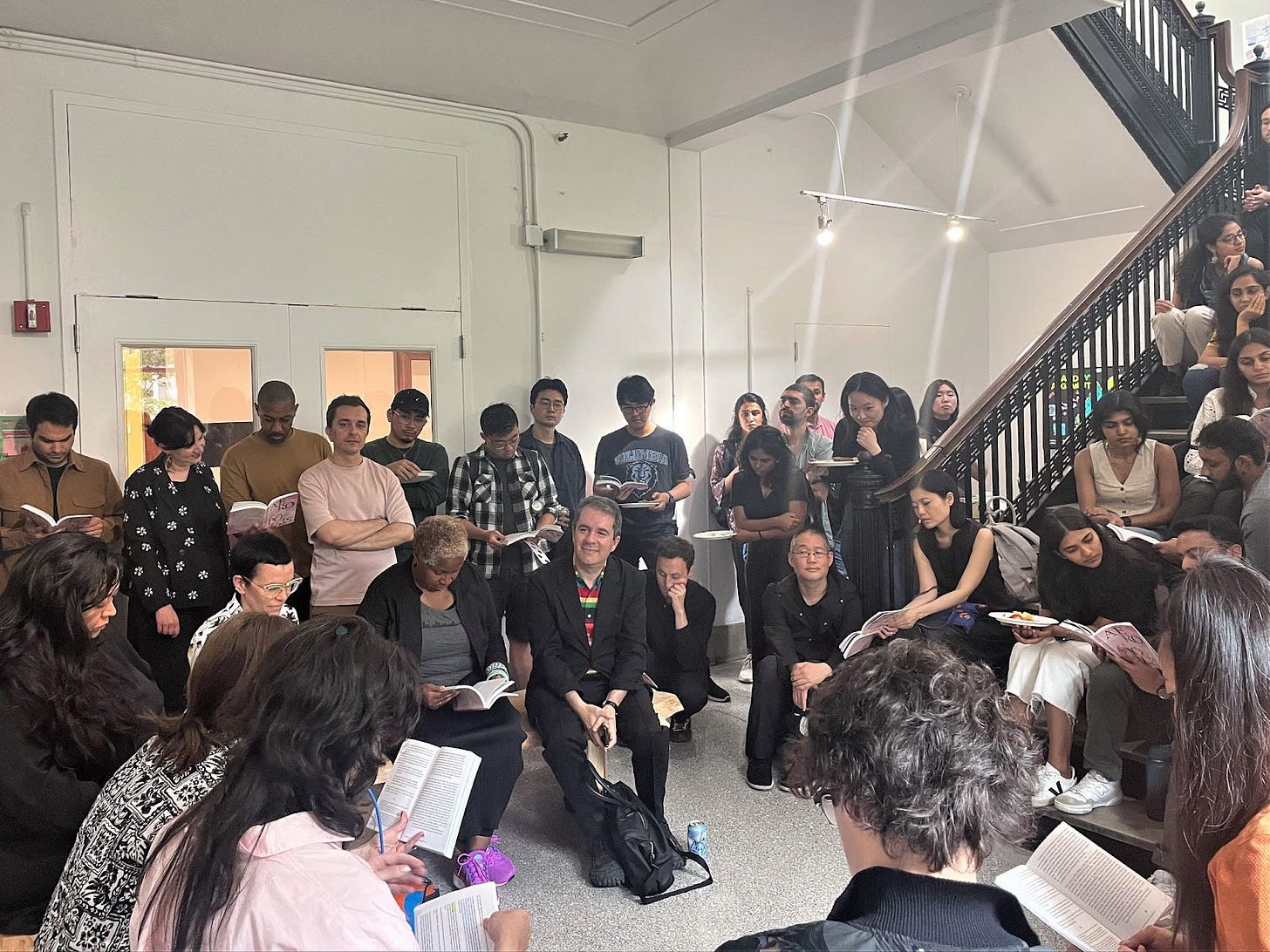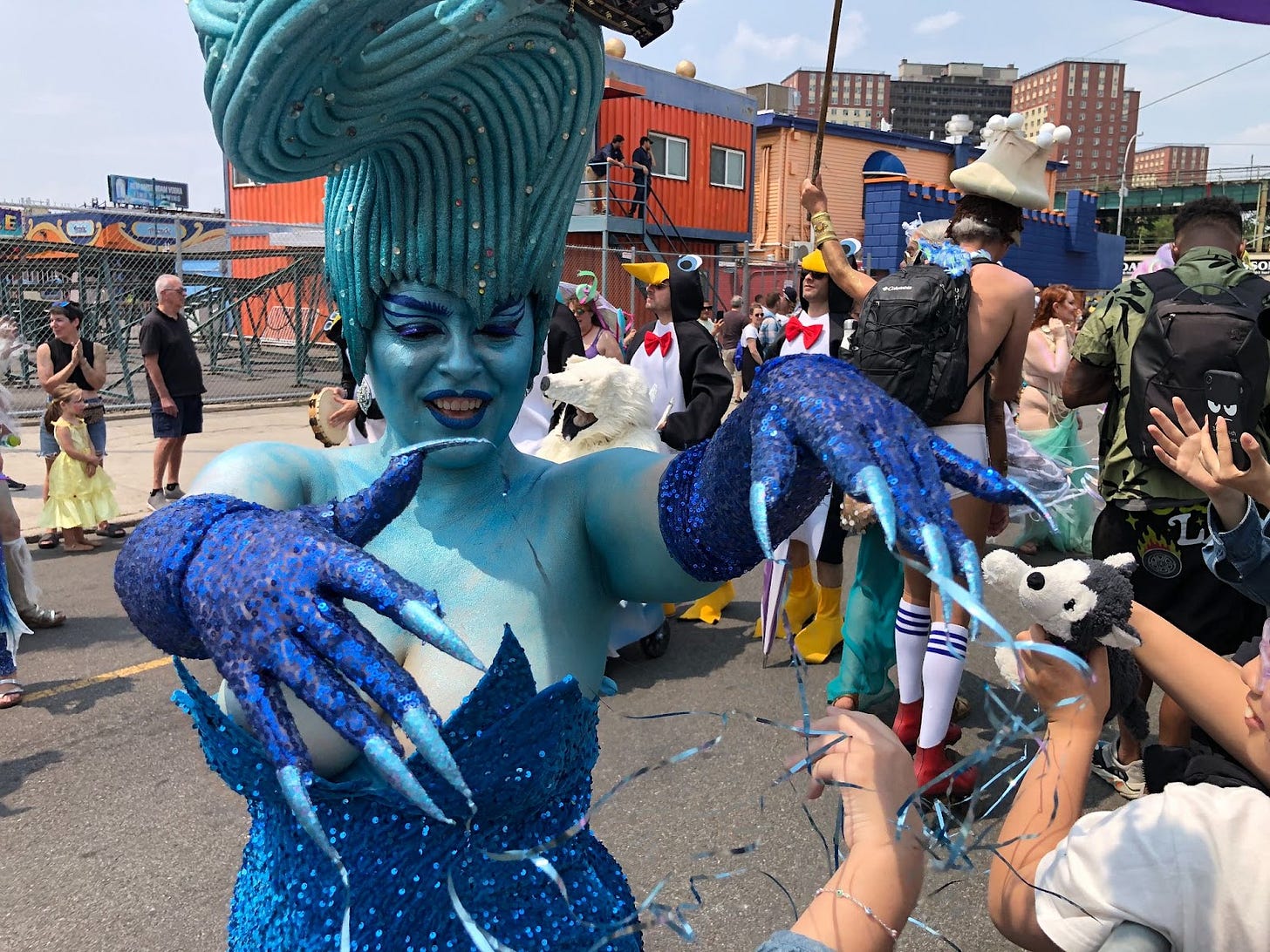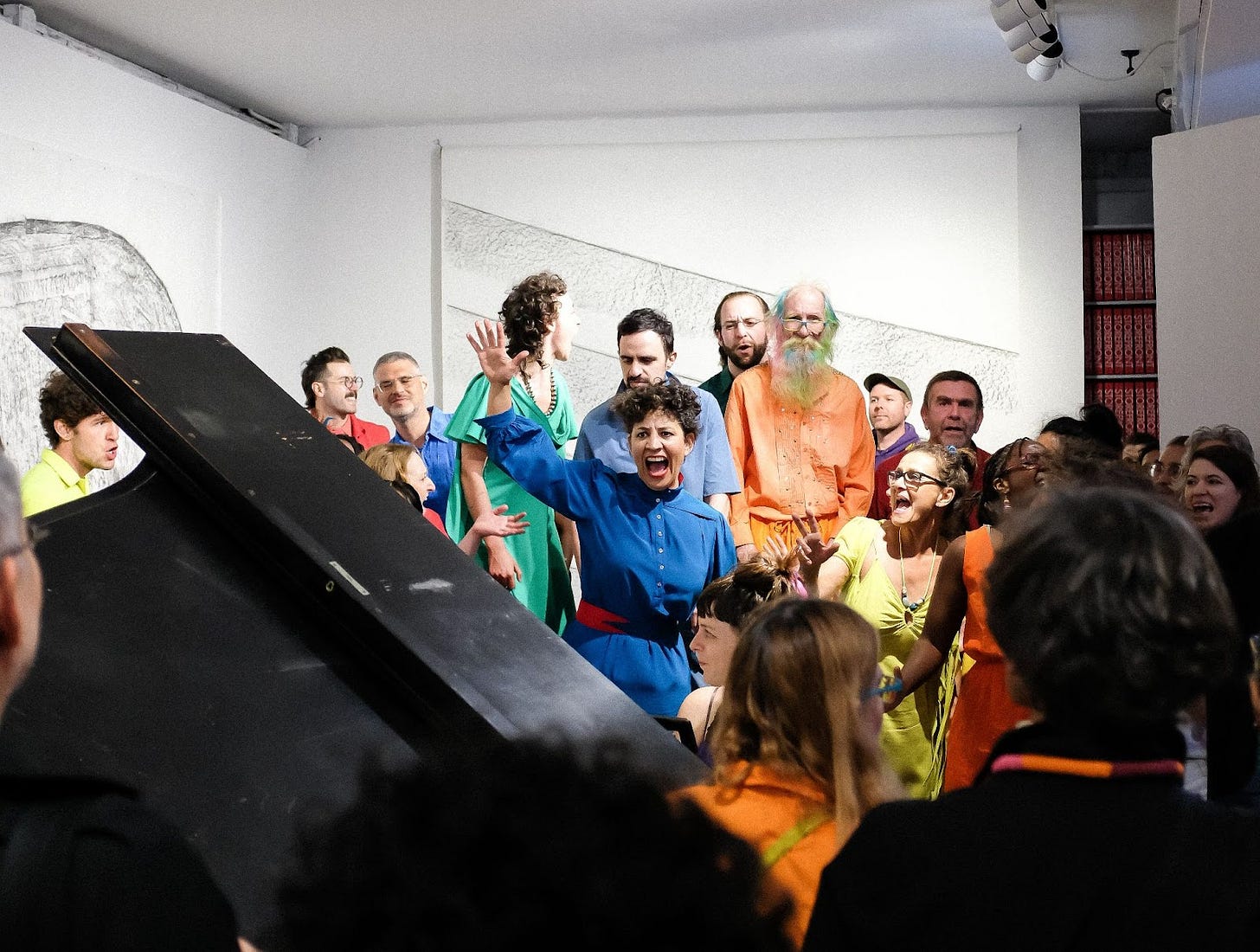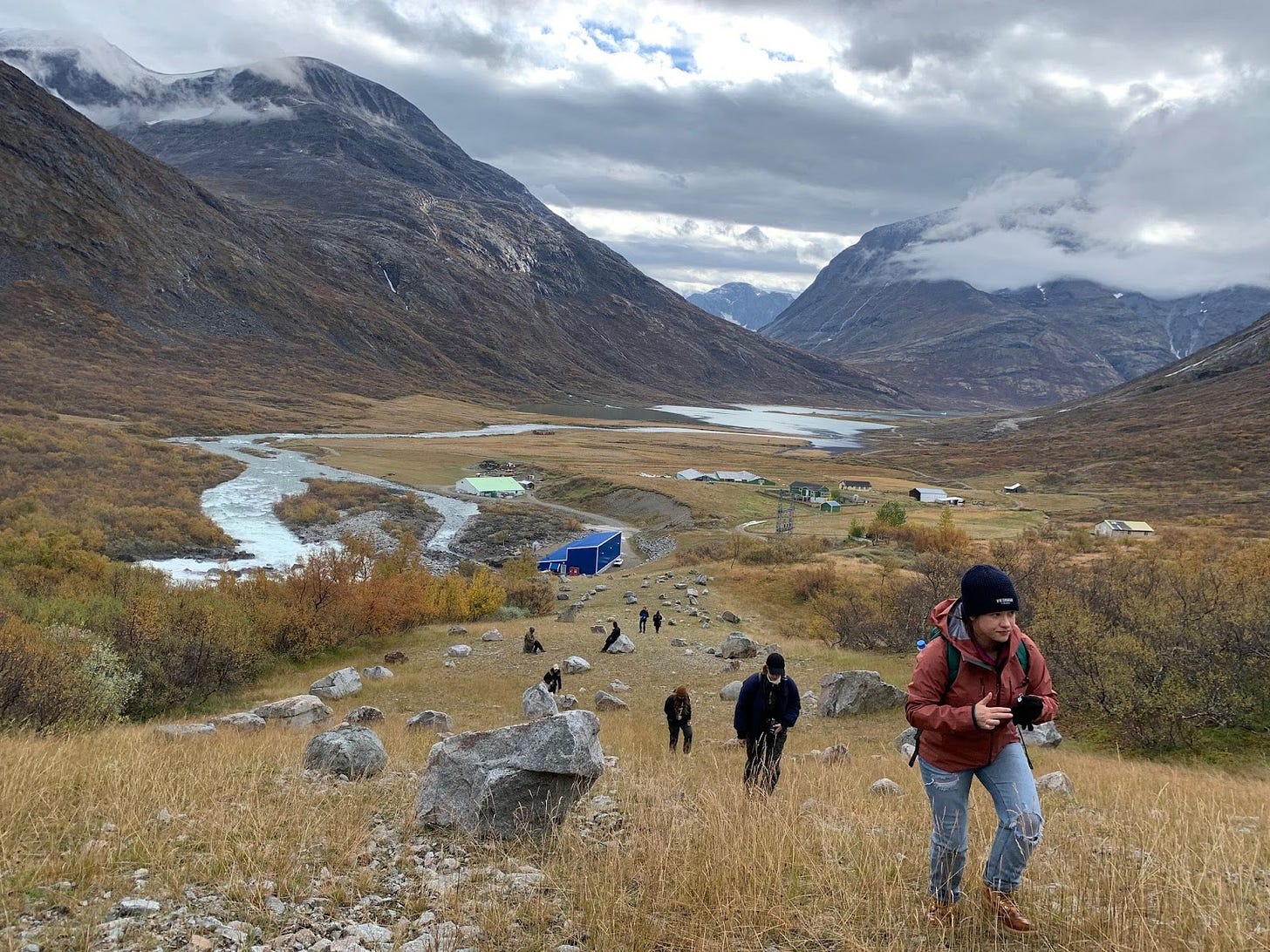S K Y L I N E | Participatory Design in Harlem
Plus public swimming in New York, the Mermaid Parade, and “Aeropolis”
Issue 118. We’re having a party next week. You should come!
This week, I interviewed architect Jerome Haferd about his project Sankofa, a thirty-two-foot circular pavilion that recently opened at Marcus Garvey Park in Harlem. The installation emphasizes collectivism, a theme that crops up in many of the dispatches in this bumper issue. Writers attended a public hearing about swimming in New York City’s rivers, the Mermaid Parade, a book launch about queer ecology and air, a design justice summit, and so on. But, there’s also tension, causing our relationship with community, with each other, to swing between need and derision. The only thing that’s stable is our newfound love for Orcas.
— Kavya Cherala
Kavya Cherala: How did the concept of Sankofa inform the installation?
Jerome Haferd: Very simply, it was to create a communal gathering space in Marcus Garvey Park, and for the architectural vocabulary to be invoking, evoking, or in conversation with the Black, African, and other non-Western cultural traditions that intersect the park. That said, exploring that connection and how the project becomes generative, experimental, and forward-looking is part of an ongoing investigation. Sankofa is an accretion of modes of making, aesthetics, and practice that trouble some of our prevailing notions of design, aesthetics, and space-making (or “space-taking”).
KC: Can you tell us more about the design process and how you worked with the community and local artists through construction? What is the labor model?
JH: The design process began with a fairly open, but provocative, idea of producing an infrastructure of care—wellness installations or pavilions—or some kind of architectural anchor and vehicle of that concept. With Justin Garrett Moore, the program officer of The Mellon Foundation, and a few others, I began to think through some possible scenarios and looked to some precedents from my practice as a starting point. There was the Harlem Renaissance Pavilion, Migrate (2020), and previous installations in Marcus Garvey Park, including Caesura (2016) and the Drum Arbor (2021), which was created for a 2021 Architectural League event honoring the landscape architect Walter Hood. Then, we engaged some members of the park community more intensely. Working with Harlem Grown, I co-facilitated a few design sessions with local community members and leaders, where we discussed ideas and made drawings and collages together. The drawings opened up a generative and productive dialogue. This allowed some of the members to express ideas about placement, program/materials, and even aesthetic lineages. They had sophisticated opinions about the outdoor pavilion as a type and didn’t want something super minimalist or cold. They wanted to see how I could create something that would feel like it “belonged” in Marcus Garvey Park.
KC: Your firm’s portfolio is broad and comprises cultural projects ranging from “program-less” follies (Curtain, 2012) to socio-political installations (Caesura, 2015), some also sited within Marcus Garvey Park. What prompted the philosophical shift? How do your projects go beyond the brief?
JH: Did we describe Curtain as program-less? Hah, thanks for the reminder. Our early work, like Curtain, was trying to gain a footing in making something in the world and observing what happens when you do that. To build on that, the projects have become more complex and layered with meaning as we have developed and gathered new, complex interests and influences over time. We’ve grown and changed as people as have our practice(s). The social and cultural landscape has evolved. À la the saying, “an artists’ duty is to reflect the times,” some of the shifts are trying to ask questions that seem increasingly urgent through the work. Also, speaking for myself, the confidence and intensity by which I’ve taken on certain explorations, precedents, sites, and histories that fall outside of the mainstream canon has grown, and you see that in some of the more recent projects that I have played a larger role in directing.
KC: What spatial ideas are better served by the ephemeral nature of sculpture or installation than by a building and why?
JH: Sankofa is pushing the DNA of what we’re used to with a public sculpture or even a “pavilion.” That said, the temporary nature serves very pragmatic logistical functions (there’s the permissibility and feasibility that comes with producing something only meant to last a short time) as well as less straightforward ones.
The ephemeral nature of the work allows for a more direct engagement and immediacy with the community, for one. The construction and design process of the built environment is very alienating to everyday folks. With this project, many local artists’ works are being shown inside the structure. There is also a fragility to the piece that I think becomes productive: it relies on the surrounding parkgoers to maintain, look after, and care for it, to some degree. This is one of the most radical things about the project and where it is. Harlem, and particularly Marcus Garvey Park, is an urban landscape with profound joy and care but also one that continues to be the backdrop for a lot of violence, trauma, and scarcity. It is powerful to have such an intimate, almost fragile communal act of care take place in real-time and model another spatial, ritual, and stewardship imaginary.
Sankofa is on view through the summer as part of the Culture, Creativity, and Care Initiative, which brings a host of programming and wellness-through-the-arts to Harlem’s Marcus Garvey Park community.
DISPATCHES
6/13: It’s Gonna Be Cool
LONG ISLAND CITY — Almost everyone who spoke at a mid-June Department of Environmental Conservation (DEC) hearing on expanding public access to waters in New York City revealed that they had swum in them, illegally. Although a Hudson Riverkeeper representative cautioned that calls to reclassify the local waters for swimming and boating did not extend to stringent contamination testing, the broad opinion in the room was to speedily push past bureaucracy, lest we fall behind in the great urban arms race for fun. Two speakers had for a time lived in San Francisco and were enamored with public swimming there. One man brought up Paris, where they are hard at work making the Seine swimmable in time for next summer’s Olympic Games. “How could New York trail the French?,” the speaker wanted to know, particularly when we have game-changing swimming technology ready at hand.
Indeed, the hearing doubled as a publicity bonanza for Plus Pool, a well-funded bobbing lido that filters river water, allowing people to swim in it. No Plus Pools actually exist, despite the idea for one in the East River being around for a decade or so. Three representatives from the organization spoke about why that should change, prompting Community Board 1 member WENDY CHAPMAN to urge the DEC to build one. “It’s gonna be cool,” she said, assuring the room that “it’ll be like the High Line.” FLEUR SOHTZ, of Plus Pool, gave stirring testimony about how much she already swims in the city’s waterways. The room nodded in approval.
Those who hogged the mic studiously avoided any mention of safety issues. The idea was simply to be able to swim in the river, which, when repeated over and over, began to sound more like a child’s fantasy than a real Idea In Which The City Should Invest. As such, the Plus Pool seems exactly in line with Eric Adams’s bizarre brand of whimsy. A filtered pool in the middle of the East River is a community project that exists within no community at all. Accessibility appears to be an afterthought— imagine taking the subway to the end of the line then walking to the water’s edge and queuing up forever all for a momentary dip. Ultimately, Plus Pool is a project for people who want to live somewhere else entirely. Give sea level rise a few more years, and they’ll get their wish.
— Lily Puckett
6/15: Gesture and Response
GRAMERCY — At the National Arts Club, WILLIAM PEDERSEN told tales from his fifty-year career like he was swapping stories with colleagues over cocktails: of his youthful hockey coach John Mariucci and one-time teammate Herb Brooks (of “Miracle on Ice” fame); his first job out of MIT at I.M. Pei’s office and initial skepticism at Pei’s parti for the National Gallery (“no compromises,” Pei told him); and his hiring by Gene Kohn at John Carl Warnecke’s office where he’d meet Sheldon Fox, prompting the formation of Kohn Pedersen Fox Associates (KPF).
But Pedersen didn’t give a plotted biography and instead focused on the firm’s efforts to tackle the office tower, what he called “the fundamental building block of the modern city.” The presentation was marked by an eerie continuity, one long march of steel and glass stretching from 1982’s 333 Wacker Drive to the 2019 completion of Hudson Yards. KPF’s early PoMo phase projects was sadly overlooked. (“We tried using a classical language [for] buildings to connect with one another. If only one building does that, it’s sort of a nice building, but if everyone doesn’t do it, it doesn’t work.”) When asked how his thinking evolved since his student days, Pedersen referred to the 1975 Aid Association for Lutherans HQ in Appleton, Wisconsin, whose integration of form, structure, and mechanical systems with a developed program—so faithful to his MIT training—wouldn’t be replicated in the skyscraper work. The spatial unity of modernism and the stylistic unity of postmodernism having been junked, all that was left was to respond to the city’s gestures, and like any cocktail party, hope conversation moves past pleasantries.
— Nicholas Raap
6/15–18: Taking Back Design
NEW ORLEANS — How many spatial designers does it take to create a protest mural? Over a hundred convened at the four-day Design Justice Summit—organized by the Design As Protest Collective and local studio Colloqate—to engage in critical workshops and forward the radical vision of social and cultural reparation through the processes and outcomes of design. In each of the five sessions, facilitators framed conversations around existing initiatives to abolish carceral spaces, preserve and invest in Black and Indigenous spaces, restructure relationships to power and labor, and promote a just energy transition. Strategies for centering community voices in design and ending hostile architecture and landscapes were deliberated. In between workshops, attendees socialized over meals, unwound in a guided yoga session, and relaxed in something called the Energy Takeback Lounge. The mural—a collaboratively made spatial representation of this year’s summit—was a fitting terminus, and evidence that the work of design justice is ultimately a collective endeavor in which all designers should participate.
— A. L. Hu
6/16: Air Can Break Your Heart
MORNINGSIDE HEIGHTS — A sudden thunderstorm forced attendees at a launch for Spanish architect NEREA CALVILLO’s Aeropolis: Queering Air in Toxicpolluted Worlds to huddle on a stairway inside Columbia University’s Avery Hall. Editors JOANNA JOSEPH and ISABELLE KIRKHAM-LEWITT initially planned to stage the proceedings out in the elements. But the change of venue was rather fitting as it made everyone hyper cognizant of the building’s stifling air and thus primed them for a conversation about the book’s themes. Aeropolis is rooted in larger discourses on queer ecology, which seek to give agency to the nonhuman, and remarks from MABEL O. WILSON, IVAN MUNUERA, and others reflected this focus. “Breathing is political,” said Munuera. “We breathe people,” added Kirkham-Lewitt. Wilson emphasized that air spoke with “multiple voices” and commented on the book’s propensity to “drift” through varying practices of relationality and care. For her part, Calvillo framed queerness as avoiding classification and dwelling comfortably in contradiction. “Aeropolis is a queering territory,” she said, before inviting everyone to become “Aeropolians.”
— Zachary Torres
6/16: Moving on Up
CHELSEA — “It’s essentially a giant planter,” said ISABEL CASTILLA, of Field Operations, at the press preview for the new Highline Connector, which opened to the public last week. Now a pedestrian can walk from the Whitney Museum to Moynihan Train Hall by crossing just one street—Eighth Avenue. The structure comprises a set of five-foot deep angled Corten steel buckets that hold so much soil that the trees in this new section will be twice as high as those on the rest of the High Line. A bridge made of Alaskan yellow cedar glulam carries pedestrians into the waiting bosom of Manhattan West. I asked: could those buckets set the High Line up to extend still further? Castilla conceded the design does not preclude the possibility.
— Nicolas Kemper
6/17: Blur Tool
CONEY ISLAND — “It’s not a costume,” BUBBLES said of her bespoke attire, a flurry of blue-green tulle, gold spandex, and a trawling net’s worth of sequins, shells, coins, gems, and starfish. “We are real mermaids: a ‘merfamily’ who comes here once a year to represent for the creatures of the sea.” It was the Forty-First Annual Coney Island Mermaid Parade, and BUBBLES, ATHENA, and SERAPHINA were there to spread the mer gospel to those gathered along the boardwalk leg of the parade route. “Fish live in the sea,” said Seraphina, “[Humans] are invading their privacy when we go in with our boats or go fishing.” And theirs is not the only display of human-marine solidarity. Thirty feet down the boardwalk, CARO BRATNOBER sported a comparatively modest ensemble of cuffed blue shorts, aviators, and a navy blue T-shirt that promotes something called the INTERSPECIES ANTI-YACHT ALLIANCE. “Orcas are attacking rich people’s yachts in the ocean,” noted Bratnober, adding in a conspiratorial whisper, “It’s not a real organization.” But if there were a lesson to the day, it was that homemade fashion can transform hopeful fictions into galvanizing community. As last year’s Mermaid winner and a twenty-year veteran of the parade, SUZIE SIMS-FLETCHER, put it, “Embrace the blur of fashion. It’s sort of like the blur of mermaids…. You put on some glitter and you blur into a mermaid!”
— Benjamin Barsotti Scott
6/17: Political Theater
KENMARE STREET—FRANCISCA BENÍTEZ’s exhibition Direct Action, opened with a performance that was part futuristic gospel, part rally. The Stop Shopping Choir, led by REV. BILLY TALEN of the Earth Church, chanted on the sidewalks of Kenmare and Cleveland before moving into the Storefront for Art and Architecture, where Benítez had installed large graphite works—rubbings of New York City property lines meant to be illustrative of urban injustice—on either side of a makeshift stage. Dressed in brightly colored outfits, the chorale belted out beguiling lyrics that entwined such ills as toxic consumerism, climate change, and police brutality (“a tree is the opposite of a cop,” “animals live like paparazzi”). The impassioned performance briefly transformed the familiar confines of Storefront’s narrow, triangular floor plan into a theater for political change. And not for the last time: Benítez and Storefront have planned similar “happenings” through the end of the summer.
— Layna Chen
6/21: Healing Touch
MIDTOWN SOUTH — “We have a lot of design-inflicted trauma,” ADAM FREED of Bloomberg Associates reflected during a roundtable discussion about public design’s potential to heal. Sponsored by the Urban Design Forum, the event was held in the “war room” of RAMSA’s Park Avenue office, whose bright-white environs offered little relief at the end of a long workday. Still, I found myself engaged in what the varied speakers had to say .
LAURA NOVA, an artist and activist, kicked off the program with an interactive listening exercise. Trauma therapist SARAH ELDRIDGE underscored the importance of being grounded and explained the factors of safety, choice, and community in making more compassionate public spaces. RACHEL SIMPSON, a partner at Purpose by Design Architects, argued for “investing in community-focused approaches,” while her colleague JULIE CHOU insisted that trauma-informed design interventions should aim to be holistically beneficial, rather than solve specific problems. Toward the end of the session, moderator GUILLERMO GOMEZ sensibly touched on the afterlife of successful interventions. How to ensure that a “maintenance of stewardship” continues to imbue such projects, he asked. The answer is clear: money.
6/22: Comfort Levels
ZOOM — “Uncomfortable,” the theme of the 2023 Architectural League Prize, is a seemingly inapposite frame for discussing new architectural investigations in housing. For DAISY AMES and SEAN CANTY, two of six winners of this year’s prize, discomfort is the disparity between worlds within and outside of “home.” The work of their respective studios questions the boundaries of traditional architectural paradigms, housing and construction policies, social and environmental values, race, and identity. Both noted that their approach is informed by traditional architectural tools of Euclidean geometry and personal narratives, and the way those are set in tension. “What is more uncomfortable than leaning into the space of one’s own identity and history,” Canty asked at one point, before adding, “Perhaps ‘uncomfortable’ is a space to reframe our own practice and narratives.”
— Malaika Kim
6/22: Faith in the Profession
LAGUARDIA PLACE — “It takes 6 hours to fly from Mexico City to NYC but 12 hours to Buenos Aires,” ENRIQUE NORTEN, principal of Ten Arquitectos, said at the start of a conference about Latin American architecture at the Center for Architecture. Norten’s aim had been to convey the sheer size of the region before identifying the region’s single most common typology: the higher-education single-building campus. Rather than the Anglo-Saxon manner of placing “objects in a garden,” the single-building campus deployed by universities from Caracas to Sao Paulo descended from the great public structures of Machu Picchu, Norten argued.
A sprint through projects of fifteen emerging Latin American architectural practices followed. The highly diverse work spanned geographies and design approaches, materials and social contexts, and all exhibited a keen awareness of climatic challenges. Projects ranged from the design of planters to the creation of new city districts and were united only by a zealous sense of responsibility. There was little handwringing to be had; indeed, the event felt like an earnest affirmation of the profession, as summed up by forthright statements from CARLOS MARTINEZ and PATRICIA LLOSA. The former, who heads up the Bogotá studio AR-AR/Martinez Arquitectura, said that he was “convinced of the transforming power of architecture and design,” while the latter, a partner of the Lima-based Llosa Cortegana Arquitectos, proclaimed that “building is the ethical duty of the architect.”
— Abubakr Hayder
6/22: Northern Exposure
CLINTON HILL — At e-flux’s newish event space, BILLY FLEMING recounted a four-day trip he took with his students to Narsaq, Greenland, last October. The talk was framed as a series of episodic encounters in which the plucky group of twelve surveys the region’s energy and water intake systems and extractive infrastructure; discovers pockets of Indigenous resistance against the mining of rare earth minerals by offshore companies; uncovers the political potency of Geiger counters and other mapping instruments in a colonized land; and is almost stranded after adverse winds down their return flight. That last aspect of the trip was the source of much social-media chatter, which blamed (perhaps unfairly) university administrators for a lack of contingency plans and criticized (on stronger footing) the climatic calculus that underwrites the travel studio model. Fleming acknowledged all this—he referred to an online article published by NYRA that captures some of the drama and desperation experienced by students—even as he stressed the plight of Greenland’s Indigenous peoples. “Those who protest [foreign mining operations] are left without robust data sets, massive in-house technical data collection and processing capacity, high-priced legal teams and council, and the ability to wage their fight indefinitely if they choose to,” he said. Rather than end on a dreary note, Fleming suggested ways in which architects might make themselves useful. “We can provide the materials, technical skills, and digital infrastructure” to those fighting for their health and hoping to reclaim rights to their own land.
— Emily Kwok
EYES ON SKYLINE
In Skyline 117, readers were most curious about yacht spaghetti.
We’re making changes to SKYLINE and want to know what you think! Take our survey!
Join us on Friday, July 7, to celebrate the launch of our new issue on at DSK Brooklyn, 710 Fulton Street, Brooklyn.
IN THE NEWS
This week…
Toronto elected its newest mayor, Olivia Chow, who announced a plan to address affordable housing by having the city build and acquire more units…
…HOK and PAU unveiled an alternative plan to redesign Penn Station…
…celebrities showed up at a public hearing arguing against the sale of a church in Manhattan…
…New York City passed a calamitous milestone this week: there are now 100,000 people in homeless shelters…
…and a Finnish city council approved a proposal to renovate a grain silo designed by Alvar Aalto.
DATELINE
The week ahead…
Thursday, 7/6
Let It Flood: Luca Danese and the Origins of Hydraulic Modernity with Andrea Bagnato
6:00 PM EST | Canadian Centre for Architecture
Friday, 7/7
2023 Summer Lecture Series: Neil Denari and Max Kuo
12:30 PM PT | Perloff Hall/Decafe, UCLA and Zoom
New York Reviews Architecture: Issue #36 Launch Party
6:00 PM EDT | DSK
Our listings are constantly being updated. Check the events page regularly for up-to-date listings and submit events through this link.
LETTER TO THE EDITOR
Write us a letter! We’d love to hear your thoughts.
New York Review of Architecture reviews architecture in New York. It is a team effort. Our Editor is Samuel Medina, our Deputy Editor is Marianela D’Aprile, and our Publisher is Nicolas Kemper.
To pitch us an article or ask us a question, write to us at: editor@nyra.nyc.
For their support, we would like to thank the Graham Foundation and our issue sponsors, Tod Williams Billie Tsien Architects and Thomas Phifer.
To support our contributors and receive NYRA by post, subscribe here.




